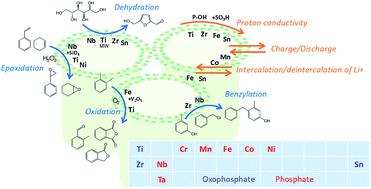当前位置:
X-MOL 学术
›
J. Mater. Chem. A
›
论文详情
Our official English website, www.x-mol.net, welcomes your feedback! (Note: you will need to create a separate account there.)
An opportunity for utilizing earth-abundant metals through the mesostructural design of metal phosphate-based materials
Journal of Materials Chemistry A ( IF 11.9 ) Pub Date : 2020-11-09 , DOI: 10.1039/d0ta09419f Tatsuo Kimura 1, 2, 3
Journal of Materials Chemistry A ( IF 11.9 ) Pub Date : 2020-11-09 , DOI: 10.1039/d0ta09419f Tatsuo Kimura 1, 2, 3
Affiliation

|
This review focused on the surfactant-assisted synthesis of metal phosphate-based materials and summarized their potential based on the design of a mesoporous structure as well as the composition and crystal structure of the inorganic frameworks. In the cases of Ti and Zr, metal phosphate frameworks are constructed through two synthetic pathways. One is a step-by-step process including phosphation of the as-synthesized metal oxides. The phosphation process is helpful for stabilizing the mesoporous structures constructed by thin inorganic frameworks. Direct synthesis is possible when the thickness of frameworks is enough for stabilizing mesoporous structures prepared using polymeric surfactants like EOnPOmEOn type triblock copolymers. Other mesoporous metal (e.g., Nb, Ta, Cr, Ga, Sn) phosphates are directly obtained using CnTMA type surfactants. In addition, unique mesostructural alterations are observed for some metal (e.g., Mn, Fe, Co, Ni, Ca as redox/ionic) phosphates. According to the nature of the metal oxide like units and surface properties of metal phosphate frameworks, the resultant mesoporous materials are broadly investigated as newly designed catalysts and/or catalyst supports for selective oxidation, acidity-dependent, photo-induced, and electrochemical reactions. For enrichment of electrochemical activities, crystallized frameworks with a suitable P/M ratio are required for fabricating electrodes for dye-sensitized solar cells, fuel cells and lithium-ion batteries. Consequently, the contents of this review provide an opportunity for designing mesostructures of a wide variety of metal phosphates containing earth-abundant metals.
中文翻译:

通过金属磷酸盐基材料的介观结构设计来利用富地球金属的机会
这篇综述集中在表面活性剂辅助的金属磷酸盐基材料的合成上,并基于介孔结构的设计以及无机骨架的组成和晶体结构总结了它们的潜力。对于Ti和Zr,金属磷酸盐骨架是通过两种合成途径构建的。一个是逐步的方法,包括将合成后的金属氧化物进行磷化处理。磷化过程有助于稳定由薄无机骨架构成的介孔结构。当骨架的厚度足以稳定使用聚合物表面活性剂如EO n PO m EO n型三嵌段共聚物制备的介孔结构时,直接合成是可能的。其他中孔金属(使用C n TMA型表面活性剂可直接获得例如Nb,Ta,Cr,Ga,Sn)磷酸盐。另外,观察到某些金属的独特的介观结构变化(例如,Mn,Fe,Co,Ni,Ca作为氧化还原/离子磷酸盐)。根据类似金属氧化物的单元的性质和金属磷酸盐骨架的表面性质,广泛研究了所得的介孔材料,作为新设计的催化剂和/或催化剂载体,用于选择性氧化,酸度依赖性,光诱导和电化学反应。为了丰富电化学活性,需要具有合适的P / M比的结晶框架来制造用于染料敏化太阳能电池,燃料电池和锂离子电池的电极。因此,本综述的内容为设计含有大量地球金属的多种金属磷酸盐的介观结构提供了机会。
更新日期:2020-11-25
中文翻译:

通过金属磷酸盐基材料的介观结构设计来利用富地球金属的机会
这篇综述集中在表面活性剂辅助的金属磷酸盐基材料的合成上,并基于介孔结构的设计以及无机骨架的组成和晶体结构总结了它们的潜力。对于Ti和Zr,金属磷酸盐骨架是通过两种合成途径构建的。一个是逐步的方法,包括将合成后的金属氧化物进行磷化处理。磷化过程有助于稳定由薄无机骨架构成的介孔结构。当骨架的厚度足以稳定使用聚合物表面活性剂如EO n PO m EO n型三嵌段共聚物制备的介孔结构时,直接合成是可能的。其他中孔金属(使用C n TMA型表面活性剂可直接获得例如Nb,Ta,Cr,Ga,Sn)磷酸盐。另外,观察到某些金属的独特的介观结构变化(例如,Mn,Fe,Co,Ni,Ca作为氧化还原/离子磷酸盐)。根据类似金属氧化物的单元的性质和金属磷酸盐骨架的表面性质,广泛研究了所得的介孔材料,作为新设计的催化剂和/或催化剂载体,用于选择性氧化,酸度依赖性,光诱导和电化学反应。为了丰富电化学活性,需要具有合适的P / M比的结晶框架来制造用于染料敏化太阳能电池,燃料电池和锂离子电池的电极。因此,本综述的内容为设计含有大量地球金属的多种金属磷酸盐的介观结构提供了机会。



























 京公网安备 11010802027423号
京公网安备 11010802027423号